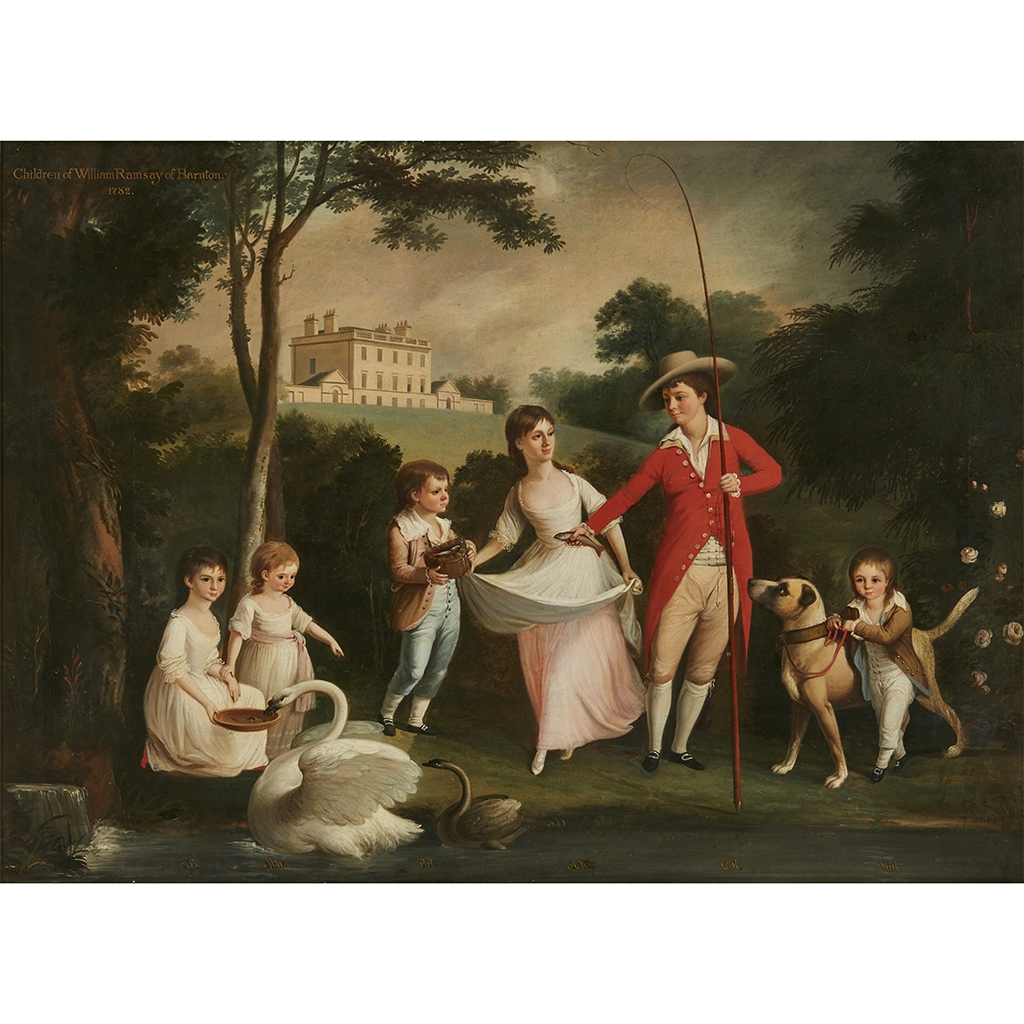ALEXANDER NASMYTH (SCOTTISH 1758-1840)
THE CHILDREN OF WILLIAM RAMSAY OF BARNTON
£96,100
Scottish Paintings & Sculpture
Auction: 9 June 2016 at 19:00 BST
Description
Inscribed, and with the children's names and dated 1782, oil on canvas
Dimensions
91cm x 122cm (36in x 48in)
Footnote
Note: Inscribed with the legend verso:- Warriston House
Agnes wife of Col. Matt Baillie of Cairnbroe
Mary wife of Capt. Chas. Hope Watson RN
Peter Ramsay
Alison wife of Sir John Marjoribanks Bt. of Lees
George Ramsay
William Ramsay
Provenance: Sir Arthur Steel Maitland Bt. and thence by descent. Sold on the instructions of the Trustees.
Alexander Nasmyth is well known as one of Scotland's finest landscape artists. He is perhaps less renowned though as a portrait painter and the arrival at auction of a major example of his work in this genre is a cause for some excitement.
The Children of William Ramsay of Barnton is a vitally important example of the 18th century cult of child portraiture and one of the key works in Nasmyth's oeuvre. Redolent with detail and symbolism, it has not been seen on the market since it was commissioned in 1782 by the Edinburgh banker William Ramsay, (whose portrait by Raeburn was sold by Lyon & Turnbull in May 2008).
Pictured against the backdrop of Warriston House, each of William Ramsay's six children is identified by the initials painted beneath their likenesses: From left to right these are: MB, WW, PR, AN (Alison), GR (George) and WR (William).
An inscription on the reverse of the painting further identifies the sitters as, from left to right:
Agnes, wife of Col Matthew Baillie of Cairnbrae
Mary, wife of Captain Charles Hope Watson RN
Peter Ramsay
Alison, wife of Sir John Marjoribanks Bt of Lees
George Ramsay
William Ramsay
George Ramsay, the eldest boy, shown in the picture wearing a red coat and a straw hat, holds a fishing rod while he brings his younger sister his catch, laying it in her apron. Close by, his brother holds George's fishing bag, completing the central focus of the painting which connects the gaze of the two brothers in a line through the eyes of their sister, thus creating a psychological relationship between the siblings.
An unwitting fourth participant in this dynamic is the family dog, who gazes up adoringly at his young master, while held by the youngest brother. Interestingly the inclusion on the left of the remarkably tame swans appears to have been a conceit of Nasmyth's and he uses it again in the group portrait of Mr and Mrs Archibald Swinton and Their Children, which dates from 1787. This painting and the Barnton portrait share other, similar qualities, including the reversed pose of the child leaning on the dog (in the Swinton painting a horse) and the inclusion of a rose bush. Notably absent in the Barnton painting of course, are the parents.
It is further possible, comparing this work with the Swinton painting, to detect the beginnings of the change in Nasmyth's work which takes hold after 1787, chiefly in the treatment of the landscape, which in the later painting hints at the influence of the artist's trip to Italy, where he studied from December 1782 to 1785. The Barnton painting is thus also important in being one of the last works in this genre painted by Nasmyth, before the stylistic changes brought about by his Italian sojourn, by which his sitters become more integrated into their surroundings.
Nasmyth had begun his career as a portraitist with a palette of blues, pinks, lilacs and purples and an attention to fabric and texture, which emulated that of his early master Allan Ramsay, with whom he worked in London from 1774 to 1778. His earliest portraits were principally of single sitters, but from 1780 Nasmyth began to paint groups in the manner of Zoffany, notably The Duke of Atholl and his Family of that year and Patrick Miller and His Children, dated to 1782, the same year as the Barnton painting. Nasmyth prefers to place his groups in a pastoral setting, often with their residence in the background, as seen here and also in his portraits of the The 3rd Earl Rosebery and his Family in the Grounds of Barnbogle Castle (1784, Dalmeny House) and Lady Honyman and her Family (c.1790, National Galleries of Scotland). Revealingly, Nasmyth is at pains to create a sense of realism in these works, placing them in the context of an actual event, generally the return from a shoot, a pony ride or, as so charmingly depicted here, from a successful fishing expedition.

